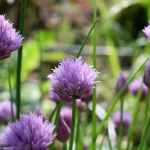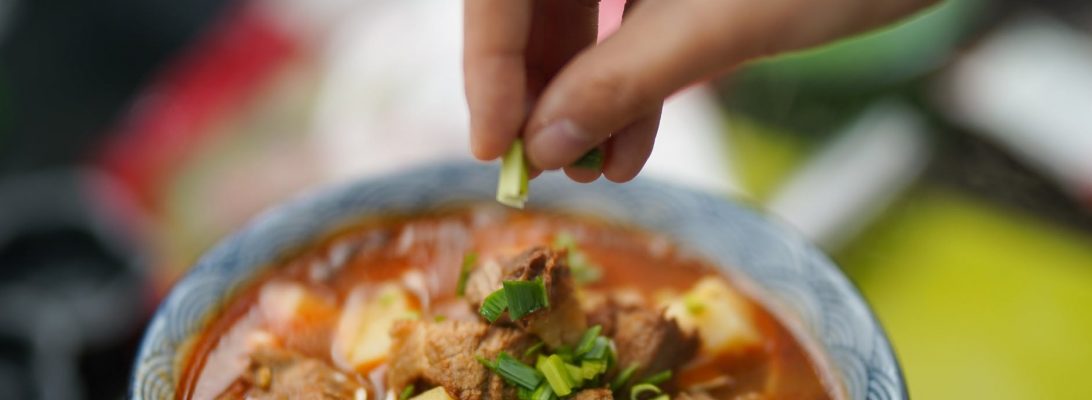
Even if you live in the city and have limited outdoor access, you can find space to nurture some key herbs. Parsley, thyme, chives, basil and rosemary are just a few of the easy to grow herbs that can add dimension and freshness to your cooking!
Urban gardener?
If you have a small porch, or some flat roof space that has good sun exposure, you can grow a core group of herbs with little fuss. I recommend using “grow bags” — reinforced canvas-type, tub-shaped pots that are easily filled with soil, once placed in the desired spot. They come with handles, so can be moved, although they are heavy once filled with soil, so best to place them where they will stay. Amazon has a number of good options that are inexpensive. You can buy them in various sizes — from 3 to 10 gallons. It’s important to keep in mind that you will need to water quite regularly, especially if the pots are in full sun six, or more hours each day. In order to promote optimal growth, use a container potting mix–not top soil, as that will compact and may impair root growth.
Keep in mind that you can get creative when growing herbs! Using beach pails arranged on a grid can work if you are really crunched on space!
If you can choose only three herbs in your urban garden, I would suggest:
- Parsley — There are two common types of parsley: Flat Leaf, or Curly. I find the flat leaf to be more versatile; it has more tender leaves that work well both for cooking and garnish. Parsley benefits from being cut, but be sure not to cut more than one third of the stems off of any individual plant. At the end of the season, you can clip all of the leaves and place them in a freezer bag; while not as good as fresh, the frozen parsley will still be great in soups and stews!
- Basil — There are lots of readily available types of basil. Sweet, or “Genovese” basil is the type commonly used in mediterranean cooking and has tender, bright green leaves. Other well-known options include Thai basil, which has a strong, pungent taste and is wonderful in Asian cuisine; cinnamon, lemon and purple varieties can add an herbaceous note to many different dishes. Basil is a tropical plant, so you will have to start anew each spring, or try overwintering in a smaller pot. Basil is readily available in the spring–you can even buy small plants at home stores for a few dollars.
- Chives — In the springtime chives produce charming, globe-shaped flowers. The blossoms are edible and add visual interest to salads and pasta dishes. Chives grow quickly and can be snipped throughout the growing season, as needed. They do well in containers and should come back year after year.



Often, co-op farms — where people buy “shares” in the farm’s produce — have plant sales in the spring and give you access to a greater variety than you might find in the typical home improvement, or small garden center. (It’s also a great way to support open space initiatives and these co-ops are frequently organic farms and so are good for the environment.)
Suburban Gardener?

Have more space and ambition? As a suburban gardener, you can grow an impressive herb garden in very little space. I have two 4′ x 4′ raised beds and have eight different types of herbs growing happily. I use raised beds as they minimize the amount of weeding required and help to discourage pests like rabbits with the placement of some simple chicken wire fencing staked around the perimeter. Having a 30″ chicken wire barrier still allows for easy access while keep the bunnies at bay! While you can buy raised beds in many styles–including models that are 3′ tall, which is great for those with mobility issues, configurable kits that allow you to construct a bed to meet your needs to other choices that do not require any hardware.
If you are lucky enough to have space for a couple of raised beds, consider adding the following selections to the three noted above:
- Thyme — I use thyme in most of my dishes and it adds a wonderful aroma and taste. Like basil, there are many varieties of thyme, including many citrus-themed plants. Tough, perennial and easy to grow.
- Sage — This attractive herb has a fuzzy “bunny ear” quality about it. Sage is great with poultry and in stuffing. Sage also adds a nice note to soup, especially vegetable soups. This is an easy-to-grow plant that has a long season. Leaves freeze well for use over the winter.
- Marjoram — Wonderful fresh, but nearly as good dried! Marjoram is reminiscent of oregano, but less pungent. This herb has an incredible aroma and adds real depth to your cooking.
- Lemon Balm — In the spring and summer, when truly gorgeous produce is readily available, there is nothing better than a simply-dressed salad with a fresh vinaigrette. Adding lemon balm to your dressing provides a wonderful citrus note! Lemon balm is also wonderful steeped as a tea and even in cookies!
- Rosemary — This mediterranean native is attractive, aromatic and versatile! In fresh form its leaves look like pine needles, which allows it to stand up to long cooking times in soups and stews. Rosemary is also wonderful when used in grilling and adds a nice note when used to flavor cooking oils.
While there are many terrific seed vendors out there, SeedSavers.org is one of my favorites, I would suggest buying young plants. You will get a jump on the season and you can lay out your beds more easily.
Remember to wait until the danger of frost has passed when planting tender herbs like basil and water consistently to ensure that the plants get well established. Some herbs will require more water on a routine basis (think basil and parsley,) while others are less fussy (think thyme and sage).
Happy Cooking!
